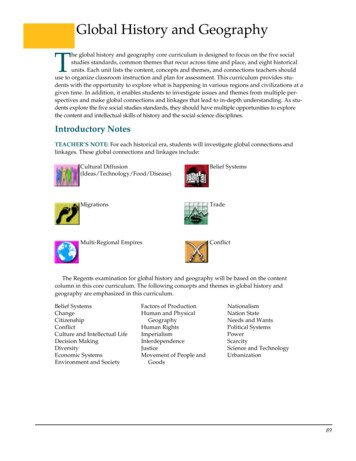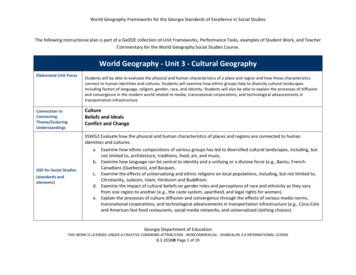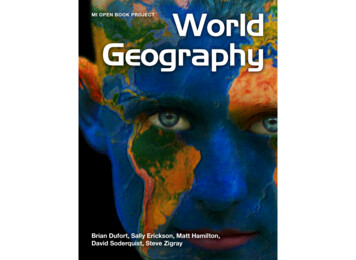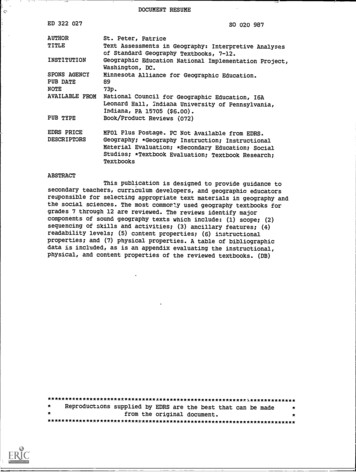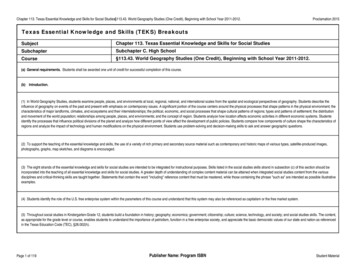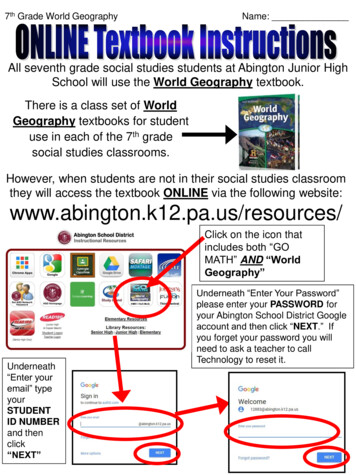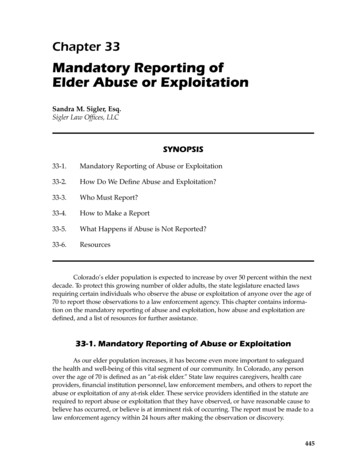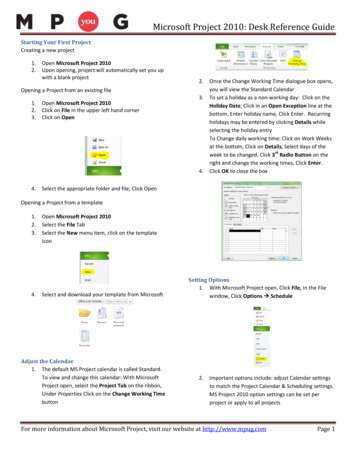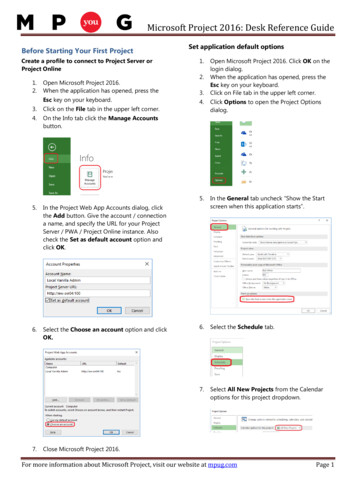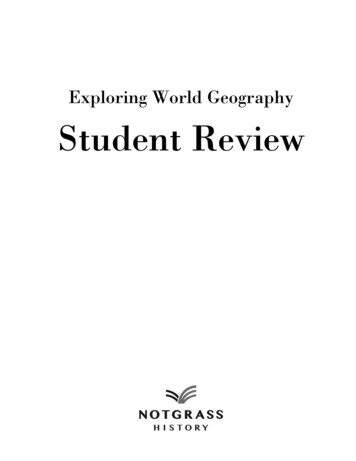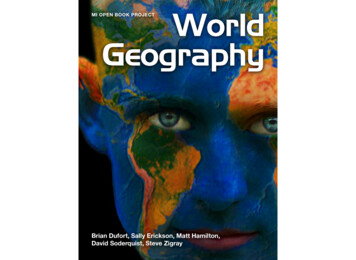
Transcription
WorldGeographyMI OPEN BOOK PROJECTBrian Dufort, Sally Erickson, Matt Hamilton,David Soderquist, Steve Zigray
WorldGeography
The text of this book is licensed under a Creative CommonsNonCommercial-ShareAlike (CC-BY-NC-SA) license as part ofMichigan’s participation in the national #GoOpen movement.This is version 1.4.4 of this resource, released in August 2018.Information on the latest version and updates are available on theproject homepage: on-NonCommercial-ShareAlike CC BY-NC-SAii
The Michigan Open BookProjectAbout the Authors - 6th Grade World GeographyBrian DufortShepherd Public SchoolsOdyssey MS/HSBrian is originally from Midland, MI and is a graduate of Northern Michigan University.He has spent his entire teaching career at Odyssey Middle/High School, an alternativeeducation program in the Shepherd Public School system. In 2001, his environmentalstudies class was one of seven programs from the United States and Canada to bechosen as a winner of the Sea World/Busch Gardens Environmental ExcellenceAward. Brian is also the Northern Conference director of the Michigan Alternative Ath-Project Manager: Dave Johnson,Wexford-Missaukee Intermediate SchoolDistrict6th Grade Team Editor: Amy Salani,Wexford-Missaukee Intermediate SchoolDistrict6th Grade Content Editor: Carol Egbo6th Grade World Geography AuthorsBrian Dufort, Shepherd Public SchoolsSally EricksonLivonia Public SchoolsCooper Upper ElementarySally has taught grades 3-6, as well as special education. She has served asa district literacy leader for many years and participated in the Galileo Leadership Academy in 2001-03. She is proud to be a teacher.Sally Erickson, Livonia Public SchoolsMatt Hamilton, East Jordan PublicSchoolsDavid Soderquist, Three Rivers SchoolsSteve Zigray, Concord Public SchoolsMatt HamiltonEast Jordan Public SchoolsEast Jordan Middle SchoolMatt grew up in Cadillac, MI. He holds a bachelor and masters degree from MichiganState University. He currently teaches middle school History and Geography. Mattstarted and advises a club at his school called the Shoe Club to inspire his students toDream Big. His wife and two daughters enjoy traveling and spending time in the outdoors.
David SoderquistThree Rivers Public SchoolsThree Rivers Middle SchoolFor the Past 11 years David has taught 6-8 grade Social Studies for Three RiversMiddle School. He serves as Department Head, School Improvement Member andSocial Studies Rep for his area. Over the past few years he has completed his Masters Degree in Curriculum and Instruction and become a state recognized Instructional Coach.Steve ZigrayConcord Community SchoolsConcord Middle SchoolSteve Zigray is a 6th grade teacher. He holds a Bachelor’s Degree from Central Michigan University and a Masters Degree in K-12 Administration from Eastern MichiganUniversity. Honors Steve has been awarded are the 2001 Junior Achievement Educator of the Year and he was nominated for Jackson Magazine’s, Educator of the year in2014. He has also coached high school and middle school sports, worked on variousschool improvement committees, wrote the 6th grade Common Assessment tests forJackson County ISD and is an active member in the community as well as the PTO. Helives in southeast Jackson County with his beautiful wife and three fantastic daughters.
Chapter 1StudyingGeographyQUESTIONS TO GUIDE INQUIRY1. What is geography?2. Why do we study geography?3. What tools do geographers use?4. What is geographic inquiry?5. Why do we need to think globally?Image source: /Land ocean ice cloud 1024.jpg
Section 1What is Geography Anyway?This year you will be studying the geography of theQUESTIONS TO GUIDE INQUIRYworld in which we live. Right off the bat, think about1. What is geography?what you already know about geography - it could be2. Why do we study geography?things you have learned in other classes at other3. What tools do geographers use?grade levels, things you’ve heard from your parents,4. What is geographic inquiry?or things you’ve heard from teachers. What comes tomind? Is it maps? Latitude and longitude? What5. Why do we need to thinkglobally?else?Interactive 1.1 What isGeography?What is Geography?Take a moment to view this briefvideo online and then answer thequestion in the blue box to thebest of your ability6
Quite simply, “Geography” broken down means “to study theculture. Like many of the disciplines in the social sciences, it is aearth” and throughout your studies in the book, we are going todiscipline that weaves the threads of the others.expand on this definition.When studying geography we are going to focus on twoaspects - physical geography and human geography. Whenwe look at landforms, vegetation, climate, bodies of water suchas rivers, lakes, and seas, we will be studying physical geography,the study of natural and physical characteristics. Humangeography is different but related. It is the study of how peopleinteract with the earth. It also includes culture, migrationpatterns, and patterns of population.The study of something often begins with a question. Thisbook itself is set around a series of questions, some smaller,some larger. Over the course of this entire world geographybook, you will explore one majorquestion: “How are we, as membersof a global society, connected?” InIf you were to go home and ask your parents aboutInteractive 1.2 InteractiveJournaleach section of this book, we willgeography they may have studied in school, they might say whenbring you back to this idea and havethey were students they memorized the states and capitals, oryou record any new thoughts andmajor countries in the world. This is only one part of whatideas that occur to you based on whatgeography really is however. To study geography is to studyyou have explored in this book andwhere we are in the world; what the world around us is like. It isthrough class instruction andthe study of who lives there and why. It can be the study of foodsdiscussion. You will be doing this aspeople eat, clothes they wear, cars they drive, and homes theypart of an interactive digital journallive in. It is the study of climate, land, economies, politics andwhich you can view here.Please note: once you havecreated your own copy of thisdocument, this widget will onlyreturn you to the blank copy. Youwill need to access yours by7opening from your own GoogleDocument.
While the teachers who have put this book together havewould wear lighter clothing? What is the average temperatureprovided some questions to focus your study, you will be askedduring winter? What is the average temperature during theand encouraged to come up with your own questions as well.summer months? One question about why people dress the wayThe process you will be guided through is known as inquiry - thethey do could lead to a series of new inquiries in the desire toact of seeking out information.learn more.Gallery 1.1 Image GalleryImage source: https://farm4.staticflickr.com/3302/3570407917 585dd5a1e8 o.jpgView the imageImage source: /Inupiat Family from Noatak, Alaska, 1929, Edward S. Curtis (restored).jpggallery above practice askingHow are the people in the picture above dressed? Why mightgeographicpeople in this place wear clothing like this? If you notice the furquestions basedhoods surrounding their faces you might think it is cold whereon the imagesthey live. If you investigated further, you would learn that this is ashown.historical photo of an Inupiat family from Alaska. It might lead youto ask more questions - are there times of the year when they8
As you continue to study “the basics,” this chapter servesnot just as an introduction to your studies this year, but also as a“how to use this book” in case this is your first time using a digitaltextbook to explore Social Studies. You will have an opportunityto practice most of the things you will be asked to do in this bookduring this introductory chapter. The last thing you will be askedto do is to once again revisit the question we posed at the start ofthis section. This time, you are going to write a brief response.What is Geography, anyway?9
Section 2Why Do We Study Geography?You might now have a better idea aboutQUESTIONS TO GUIDEINQUIRYwhat geography is, but why do we study it?1. What is geography?There are many reasons. Take a moment toview the video clip here about how some2. Why do we studygeography?people use geography in their chosenprofessions.3. What tools dogeographers use?Interactive 1.3 What canyou do with geography?4. What is geographicinquiry?5. Why do we need tothink globally?Learn more about whatgeographers do with this YouTubeclip (requires internet connection)Image source: /JohannesVermeerTheAstronomer(1668).jpg10
Why we study geography is a question many have asked.While to some geography is viewed only as maps, in reality it haslinks to science, mathematics, literacy, literature, and the othersocial sciences.think critically. It provides opportunity to inquire about the worldaround you and research to find answers.Geographers study the “why of where” which can besimplified to “why there?” or “why here?” You may have studiedthe early history of the United States in other social studiesclasses. Where did early settlements like Jamestown tend tospring up and plant roots? It was generally around watersources. A geographer would then ask and seek to explain “whythere?”The image on this page is not an all inclusive list of why we studygeography, but it does include many of the major reasons we willoutline as you go through this book.Studying geography can provide you with an overview of theplanet upon which we live. People who study it are betterequipped to understand topics such as why people live wherethey do, what causes people to move between places, how weuse our natural resources, why countries and locations are brokenup into geographic regions.the list goes on and on!In addition to knowing about our planet and the people wholive there, people study geography because it helps you learn to11
affecting morecountries thanjust Japan. Weare citizens ofthe UnitedStates ofAmerica, but nomatter where welive, we are alsoresidents of thisball of rockfloating inWinter sunrise at Michigan’s St. Joseph LighthouseImage source: John McCormick/ShutterstockUnderstanding the world around you - Why does Michiganspace. Whatdoes that mean?Image source: /2011 Tohoku earthquake observed tsunami heights en.pnggenerally have colder temperatures in the winter than Florida?Why is a home on the beach so expensive? Have humans hadLearning about people and societies - If you slurp your soup inan effect on the climate of the earth? When studying geographyAmerica, folks might call you rude. Burp at the table and it’syou can learn the answers to questions such as these which helppossible your parents might send you to your room without anyyou make sense of the world around you.dessert. In Japan however, holding a bowl of soup and noodlesBecoming a global citizen - Back in the early 1900s it could takea person coming from Europe to America over a week to make itfrom one port to the next. Now, flights leave major airports andhave people at their destination within hours. When a naturaldisaster happens in one part of the world, it can affect daily life onanother. A tsunami in Japan back in March of 2011 ended upup to your mouth to eat it is considered a sign to the chef that thefood is delicious. Slurping and all! In parts of China, burpingafter a meal is considered a sign of appreciation. Religiouscustoms vary from country to country - the five major worldreligions (discussed in more depth in later chapters) all helpdictate traditions and customs in parts of the world. Studying12
geographyConnections -allows you toAll of these things together help us explore the idea of how thelearn more thanworld around us affects every day life, as well as thejust where aconnections between how we relate to all of that.country islocated on aFor that reason, the inquiry question we will keep coming backmap, but whatto throughout the course of this book is:the people and“How are we, as members of a global society, connected?”society are likeas well.This question is not studied because there is a /2/23/JapaneseBosozoku.jpggovernment that unifies the planet, but more to help you realizethat whatever country you are from is one of many, and thatactions in one place can have effects on other places.Take a moment to record your thoughts to that question. In thenext section we will begin to look atLearning about locations - Thissome of the tools that geographersmay be the piece of geography thatuse.sticks in almost everyone’s mind,but geography is the study oflocations. We do this by studyingmaps, pictures, GeographicInformation Systems data, visitingand exploring these places, amongothers.Image source: /World map 2004 CIA large 1.7m whitespace removed.jpg13
Section 3What Tools Do Geographers Use to Study the Earth?If you were to ask 100 people what tools geographersQUESTIONS TOGUIDE INQUIRYuse to study the earth, one of the first answers you will1. What is geography?undoubtedly hear will be “maps.” And it is true that mapsare one of the most common tools used to answer2. Why do we studygeography?geographic questions. A map is a visual representation ofthe earth, or parts of the Earth and can showcase a variety3. What tools dogeographers use?of spatial scales.4. What is geographicinquiry?scales? You can represent a5. Why do we need tothink globally?very small portion of the mapwith great details. Below is anWhat are those spatialA Note On Scale:Interactive 1.4 GoogleDrive Journal ActivityThe map activity on this page isset to focus on a city in NorthernMichigan at the most zoomed-inscale. This is called thesmallest scale because objectslike buildings and roads areInteractive 1.5 GoogleMapsembedded map from Google. It is setto a city in Northern Michiganzoomed in as far as that particularmap can go to. Take a moment toexplore that map at different scalesand then complete the Google Drivejournal activity located here.shown at their largest size. At amore zoomed-out scale, objectslike buildings and roads may beRefer to this handout togetherwith the Google Maps widget.so small that we cannot seethem.14
If you were to take a balloonMapsMaps are able to show information about geographic areas.Every map has at least one purpose. They can represent a placesuch as a neighborhood, a town, a country, or the world overall.Sometimes they can show human features. In the very first mapyou looked at in the Google Maps link above, what humancharacteristics such as roads, buildings, etc. were you able tosee? When you zoomed all the way out, were you still able to seeany human characteristics?When your parents were younger, they probably went on aand inflate it, then draw a map ofthe world on it, you could, if youInteractive 1.7 MapProjections Videowere careful, get a very closeapproximation of what the worldoverall looks like. If you wereextremely careful you couldrepresent the continents of theearth drawn to a precise scaledsize. This is because a balloon is around, three-dimensional object. ALearn more about map projectionswith this video. (Requires internetconnection)trip with their families which involved using a map of a state ormap, however, is a two-dimensionalregion to get to their final destination. Modern technology suchobject. If you were to pop that balloon (much like peeling theas smart phones have GPS built in which has made these twoorange in the video above) what you are left with is a much lessdimensional maps obsolete for that purpose. A road trip is notuseful representation of the earth.the only use for a map of a city or a state, however. Maps canrepresent a variety of different features about a place. There is asmall problem with maps however In an attempt to represent a three dimensional object in twodimensions, mapmakers, known as cartographers, have createdInteractive 1.6 The Orangedifferent ways to represent the earth. These are known as mapprojections. There are hundreds of different types of projectionsand each has plusses and minuses in its usage.15
Take this map forrepresentedexample. This is knowncloser toas a Mercator projection.their actualA Mercator projectionscales. If,would be an excellenthowever,map for a navigator on ayouship. In fact, this kind ofcomparemap was extremely usefulthis map toin navigation. One of thethe Mercatorproblems with this map isthe distortion of size. IfImage source: /Gall%E2%80%93Peters projection SW.jpgyou look at Greenland on this map, it appears to be huge.projection,what do younotice aboutAustralia, the small continent in the bottom right hand portion ofthe shape of land masses? There is a distinct distortionthe map, looks like it is much smaller than Greenland. In actualitysomewhere onhowever, Greenland is much smaller. Antarctica almost appearsthe map.to be as large as the rest of the continents together. So, while aMercator Projection is a great map for use in navigation, it doesnot project the world as it is due to the distorted size of certainareas.The nextprojection wewill take a lookat is known asa RobinsonAnother well known map projection is known as a Gall-PetersProjection, or more commonly, a Peters Projection. There is agreat controversy surrounding the origins of this map, which youmight want to take a few minutes to look up in the future. In aprojection such as the one above, parts of the world areProjection.Generallyspeaking, aImage source: b/9/96/Robinson projection SW.jpg/1280px-Robinson projection SW.jpgRobinsonprojection is an attempt to compromise and show thelandmasses as close to their natural size and shape as possible16
on a two dimensional representation. It too, however, suffersBelow is a gallery of many different map projections. As you flipfrom distortion. In this case, much of the world is shown as closethrough the gallery, think about how each map might be useful,to scale as possible, but as you move toward the top and bottomand what the disadvantages of the map might be.of the map, what do you notice happening?Now, think back to the video you watched at the beginning aboutGallery 1.2 More Map Projectionsthe orange. Another projection is known as the GoodeHomolosine Projection, more commonly known as an InterruptedProjection. In this projection type, there is very little distortion interms of size of continents, however it is very difficult to calculatedistances on a map such as this. If you were taking a plane ridefrom New York to London, it would be difficult to figure out theexact distance if this were the only map available to you.Image source: /Goode homolosine projection SW.jpg17
one portion of the United States seems to have a lot ofthese lights, while large portions of the Western half of theUnited States are much spottier. A “why” question ageographer might ask about this would be: “Why are thereImage source: http://pixabay.com/p-92367/?no redirectSo, yes.maps are one of the many tools that geographers use tostudy the earth. But what are some of the others?Image source: /Washington, D.C. 2007 aerial view.jpgmore large urban areas on the eastern half of the United Statesthan the western half?” By looking at this image, geographersAerial Photographs and Satellite ImageryWhen you look at the image above, what do you see? This is amight then look at maps and other aerial photographs to get ananswer to this question.satellite image captured of the United States. The “gold” on themap represents city lights, which in turn can help someonestudying this image understand where some of the majormetropolitan areas are in the United States. You will notice that18
A satellite image has many purposes and can be helpful at astand-alone unit, sends information up into the sky where itvariety of spatial scales from large to small. An aerial photographconnects with a satellite, which then determines your position onis similar to this, but is generally speaking at a larger. The aerialthe planet. This information is then relayed back to the user andphotograph that shows Washington, DC, shows a zoomed-indisplayed on a map. Aside from just locating yourself on a map,view of a city at a larger scale in which we can see individualhow might GPS be a useful tool for geographers?buildings and streets. A picture like this one might help someonestudy patterns of development for neighborhood planning. ItGIS (Geographic Information System)could be useful in surveying an area for a potential buildingA geographic information system, commonly referred to as GISproject. Other aerial photographs could be useful in determiningutilizes software and hardware to collect and display data. It canlocation of farmland, where irrigation systems could be created,help you display forms of information useful for geographers toamong many other things. Both of these tools are useful forexplore. It is a combination of map making (cartography), datageographers in answering their “why” and “where” questions.GPS (Global Positioning Systems)Do your parents have a smartphone they sometimes use toget directions to places they have never been? What about you?Global PositioningSystems (commonlyreferred to as GPS)make use of satellites inorbit to collectinformation about wherethe user is on the earth.Your GPS device, be ita phone or acommercially availableImage source: /GvSIG - GIS.jpgImage source: /GPS Receivers 2007.jpg19
about places, and computer technology to create aReturn once more to the “What Tools Do Geographers Use torepresentation of places. Someone who uses a GIS is then ableStudy the Earth” note guide. There is one final question for youto create a representation of places by layering information on topto explore before moving into the next section.of the map and allowing the people using them to manipulateinformation in an attempt to better understand a place.Other toolsYou may not initially think of things like stories, people, charts,tables and graphs as being things a geographer might use,however, even with a wealth of other tools such as maps, satelliteimagery, and GPS and GIS available, more information is neededInteractive 1.8 GoogleDrive Digital Journal Activityin pursuit of the answer to the questions of “why” and “where.”In this case, geographers use some of the same tools aseveryone else to explore and learn more, such as data in tables,and charts and graphs which can help with numerical data abouta place. If a geographer is trying to understand why peoplesettled in a given area, they might look back at historical dataabout when people came to a region in an attempt to understandwhy. They might also look at primary source documents - firsthand accounts from people who lived during the time to get asense of why people came there. If movement to this region wasrecent, they might even interview living people to get clues.What has been outlined in this section is by no means a full listthat shows you every tool a geographer can use. It focused onsome of the most common ones, and you’ll et practice with theseand many more throughout the book.20
Section 4What is Geographic Inquiry?QUESTIONS TO GUIDE INQUIRYSo far you have learned about what geography is, why you are going study it, and1. What is geography?what tools geographers use. One of the most important things to remember is2. Why do we study geography?that just like people in every field, geographers ask questions. Geographers gothrough an inquiry process every time they ask themselves a question on3. What tools do geographers use?something that interests us, whether we are aware of it or not. The first step is4. What is geographic inquiry?asking the right question. From there, you go out and find the right information.5. Why do we need tothink globally?You evaluate, sometimes without knowing it,whether the information is “good” or not, beforefinally coming up with your conclusion. Theseare all steps in a good inquiry process.Geographic inquiry is no different. For thepurposes of this book the following process willbe used:21
Ask a geographic questionTo begin any inquiry, you need to have a question in mind. If youare having a hard time beating a boss in a video game, you mightask “How do I get past the level 12 boss?” This is certainly aalso use a map that is more zoomed in so you can see morespecifically how streets connect a parking lot to the concert site.All of this information helps you as you begin the next stage ofgeographic inquiry.question you can research, but it probably is not a question ageographer would use. Geographers are going to ask questionsabout where things happen, what happened, and why ithappened. Two geographers headed to a rock concert (music,not stones) might wonder why it costs 15 an hour to park theircar in the lot right next to the venue, the place where the concerthappens. This is one of those times where economics alsocomes into play. If they drove several streets over, there might becheaper parking lots. In this case, they may think the answer tothis question is “convenience.” The closer you are to yourdestination, the more expensive it is to park there. To be certainhowever, they are going to have to do a few more things.Acquire Geographic InformationThe second step once you have your question is to go out andgather some information. In the rock concert example above, ageographer probably would not look at a world map to figure outwhere to park, but if you think back to the geographic tools wediscussed in the previous section, you might look at aerialphotographs to see where available parking might be. You mightOrganize Geographic InformationThe date of the concert is approaching and the geographers’excitement grows. They do not want to pay too much, however,so now that the question has been asked and they have anopportunity to collect some resources, it’s time to explore andorganize that data. As they look through aerial photographs ofthe area to determine the number of parking lots in walking22
distance of the concert venue, they also might have receivedinformation from the city website on how much the parking costsat various locations. At this point they may create their ownspecial map which showcases prices. Once this is done, theyare ready for the next step.Answer Geographic QuestionsFinally, the day of the concert arrives and our geographers areready to attend with all of the best knowledge on where to park inthe city. Not only are they going to attempt to land themselves aparking spot at points three or four on the map so they have moremoney for souvenirs, but they conduct a little more geographicAnalyze Geographic Informationinquiry to figure out how long it will take them to walk from theirparking spot to the venue. They leave secure in the knowledgeOnce their map has been assembled with the most up-to-datethat they went through the geographic inquiry process to answerdata they have available, it is easy to see the available publicthe important question about why parking so close to the concertparking lots that are the furthest away from location A (thevenue is more expensive.concert venue) are cheaper than the ones located right near thevenue. While our example has been relatively simple, sometimesit takes a long time to analyze the geographic information that hasbeen collected and organized in response to a geographicquestion. And sometimes, as you get further into the inquiryprocess, you might need to return to earlier steps. Perhaps it isasking a different question. Maybe you need more information toreach your conclusion. Inquiry can be messy, but once you havethe right question and the right data, you can move to the finalstep.Image source: Andrey Yurlov, Shutterstock23
geography they may have studied in school, they might say when they were students they memorized the states and capitals, or major countries in the world. This is only one part of what geography really is however. To study geography is to study where we are in the world; what the world aroun
